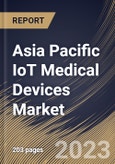Using AI in IoT, many symptoms of depression can be detected as soon as they manifest. This, in turn, could prompt various responses to help treat depressive states, such as altering the lighting in a room or administering medication. Moreover, chronic obstructive pulmonary disease (COPD) is the third leading cause of mortality, but early diagnosis and treatment can help to reduce or eliminate many of its symptoms.
IoT devices, sometimes known as smart inhalers, can monitor the frequency of attacks, assess environmental data (such as air quality) for potential triggers, and record the amount of medication administered during an incident. This information could be used in various ways to enhance the treatment or management of COPD, ranging from improved medication scheduling to heightened awareness of environmental triggers in a given space. Medical facilities can also monitor this data to determine the severity of a patient's condition to prescribe a treatment plan better.
The Indian government has recognized the potential of digital health to strengthen the nation's healthcare delivery system. Various schemes/programs for implementing the digital health initiative have thus been initiated. The Ayushman Bharat Digital Mission (ABDM) has been introduced to foster the adoption of digital health technologies in the health domain. Under the ABDM, the Health ID, Health Professional Registry (HPR), and Health Facility Registry (HFR) and the digital infrastructure for data exchange have been developed. To ensure continuity of care, the digital health ecosystem established by ABDM enables the seamless exchange of data between primary, secondary, and tertiary facilities. All these developments in the Asia Pacific region benefit the market.
The China market dominated the Asia Pacific IoT Medical Devices Market by Country in 2022 and would continue to be a dominant market till 2030; thereby, achieving a market value of $19,904.1 million by 2030. The Japan market is registering a CAGR of 29.5% during (2023-2030). Additionally, India's market would showcase a CAGR of 31.1% during (2023-2030).
Based on Product, the market is segmented into Vital Sign Monitoring System (ECG/Heart Rate Monitor, Blood Pressure Monitor, Blood Glucose Monitor, Oximeters, and Others), Hearing Devices, Imaging Systems, Implantable Cardiac Monitors, Patient Monitors, Respiratory Devices, Infusion Pumps, Ventilators, Anesthesia Machines, and Others. Based on Connectivity Technology, the market is segmented into WiFi, Bluetooth, and Zigbee & Others. Based on Type, the market is segmented into Stationary Medical Devices, Wearable Medical Devices, Implantable Medical Devices, and Others. Based on End-user, the market is segmented into Hospitals & Clinics, Nursing homes, assisted living facilities, long-term care centers & home care settings, and Others. Based on countries, the market is segmented into China, Japan, India, South Korea, Singapore, Malaysia, and Rest of Asia Pacific.
The market research report covers the analysis of key stakeholders of the market. Key companies profiled in the report include Medtronic PLC, GE HealthCare Technologies, Inc., Koninklijke Philips N.V., Abbott Laboratories, Boston Scientific Corporation, Omron Corporation, Baxter International, Inc. (Hill-Rom Holdings, Inc.), Johnson & Johnson, Nihon Kohden Corporation and Siemens Healthineers AG (Siemens AG).
Scope of the Study
By Product
- Vital Sign Monitoring System
- ECG/Heart Rate Monitor
- Blood Pressure Monitor
- Blood Glucose Monitor
- Oximeters
- Others
- Hearing Devices
- Imaging Systems
- Implantable Cardiac Monitors
- Patient Monitors
- Respiratory Devices
- Infusion Pumps
- Ventilators
- Anesthesia Machines
- Others
By Connectivity Technology
- WiFi
- Bluetooth
- Zigbee & Others
By Type
- Stationary Medical Devices
- Wearable Medical Devices
- Implantable Medical Devices
- Others
By End-user
- Hospitals & Clinics
- Nursing homes, assisted living facilities, long-term care centers & home care settings
- Others
By Country
- China
- Japan
- India
- South Korea
- Singapore
- Malaysia
- Rest of Asia Pacific
Key Market Players
List of Companies Profiled in the Report:
- Medtronic PLC
- GE HealthCare Technologies, Inc.
- Koninklijke Philips N.V.
- Abbott Laboratories
- Boston Scientific Corporation
- Omron Corporation
- Baxter International, Inc. (Hill-Rom Holdings, Inc.)
- Johnson & Johnson
- Nihon Kohden Corporation
- Siemens Healthineers AG (Siemens AG)
Unique Offerings
- Exhaustive coverage
- The highest number of Market tables and figures
- Subscription-based model available
- Guaranteed best price
- Assured post sales research support with 10% customization free
Table of Contents
Companies Mentioned
- Medtronic PLC
- GE HealthCare Technologies, Inc.
- Koninklijke Philips N.V.
- Abbott Laboratories
- Boston Scientific Corporation
- Omron Corporation
- Baxter International, Inc. (Hill-Rom Holdings, Inc.)
- Johnson & Johnson
- Nihon Kohden Corporation
- Siemens Healthineers AG (Siemens AG)








